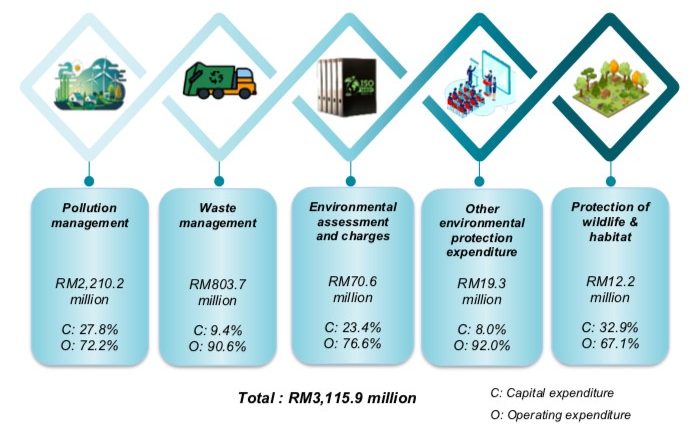- Loss of tree cover 2010-2021 has cost nation 4.99Gt of CO2 emissions
- Carbon estimate from 2019 puts US$250bil price just to offset same amount

The Department of Statistics Malaysia (DOSM), last week, released the Environmental Protection Expenditure 2022 report (for reference year 2021). The report includes capital and operating expenditures for pollution management, waste management, environmental assessment and charges, protection of wildlife & habitat and other environmental protection expenditure, totalling US$664 million (RM3.1 billion), up by 4.8% from 2020.
This US$664 million accounts for 0.2% of GDP in 2021, much lower than that spent by Brazil (0.5% of GDP) and Poland (0.56% of GDP) according to the IMF. Granted, these involve national accounting where the baselines may differ by country. (Poland and Brazil are often used as comparison countries for Malaysia based on the measure of GDP per capita for middle higher income countries). For further context, the general government expenditure in the EU on ‘environmental protection’ amounted to 0.8% of GDP in 2021.
Of grave concern, however, is the amount spent on the protection of wildlife and habitat – US$2.61 million (RM12.2 million).
[Ed: The full publication of the Environmental Protection Expenditure 2022 can be downloaded at eStatistik.]
The then Ministry of Natural Resources and the Environment (since renamed Minister of Natural Resources, Environment and Climate Change) had released its National Policy on Biological Diversity 2016-2025, with specific targets to ‘safeguard key ecosystems, species and genetic diversity’.
One of the concerns raised when the policy was released had to do with the stated goal of conserving ‘at least 20% of terrestrial areas and inland waters, and 10% of coastal land and marine waters’ by 2025.
Critics found the bar set too low. Even Bank Negara Malaysia had considered the implication on economic and financial stability from biodiversity loss – quoting a 2021 study which found that a 90% reduction in certain parts of the ecosystem would lead to a loss equal to 6% of GDP by 2030. The stark point however is that this RM12.2 million in 2021 is a 32.3% reduction from 2020.
One would assume that the cost would be increasing year-on-year as the 2025 target approaches.
The issue here is that there is a direct link between protecting habitat and our achieving net-zero ambitions. The paradox ought to be clearer to our policymakers. Loss of tree cover between 2010 and 2021 has cost us 4.99Gt of CO2 emissions.
Using the US$50 per ton of carbon estimate from 2019 puts that at US$250 billion just to offset that same amount. Contrast this with the RM350-RM400 billion we are estimated to need to meet our net-zero-by-2050 target.
There are of course no definite figures. Carbon prices fluctuate and estimates of net-zero spending, are exactly just that, estimates. But the basic argument should stand – we can either spend to protect our biodiversity or pay to repair the damages later. We are one of 17 countries deemed to be megadiverse. That should be worth paying the price to protect.

